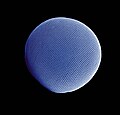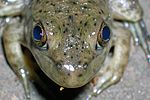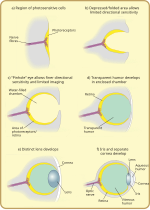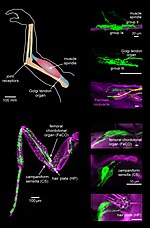A simple eye or ocellus (sometimes called a pigment pit) is a form of eye or an optical arrangement which has a single lens without the sort of elaborate...
23 KB (2,655 words) - 07:53, 23 June 2024
thousands of lenses per eye. In contrast to compound eyes, simple eyes have a single lens. Jumping spiders have one pair of large simple eyes with a narrow...
59 KB (7,514 words) - 23:40, 26 August 2024
main, compound eyes. Arthropod eye Mollusc eye Simple eye in invertebrates Vision in fish Eakin, R. M (1973). The Third Eye. Berkeley: University of California...
14 KB (1,592 words) - 13:50, 30 August 2024
Cat senses (redirect from Cat eye)
into the eye. They also have a high number of rods in their retina that are sensitive to dim light. While these improve the ability to see in darkness...
20 KB (2,385 words) - 18:31, 5 June 2024
Simple eye in invertebrates Vision in fish Visual system Serb, J. M.; Eernisse, D. J. (2008). "Charting Evolution's Trajectory: Using Molluscan Eye Diversity...
3 KB (319 words) - 07:43, 18 March 2024
Spider vision (redirect from Spider eye)
in their structure, arrangement, and function. They usually have eight, each being a simple eye with a single lens rather than multiple units as in the...
12 KB (1,272 words) - 23:24, 9 July 2024
the retina of vertebrate eyes Simple eye in invertebrates (Ocellus), photoreceptor organ ("simple eye") of invertebrates often composed of a few sensory...
1 KB (163 words) - 17:02, 31 August 2024
were thought to grow in rows, inserted between existing rows of ocelli. Mollusc eye Parietal eye Simple eye in invertebrates Vision in fish Optic lobe (arthropods)...
30 KB (3,575 words) - 21:52, 11 June 2024
Mollusc eye Parietal eye Simple eye in invertebrates Visual system Meyer‐Rochow, V. Benno; Stewart, Duncan (1996). "Review of larval and postlarval eye ultrastructure...
66 KB (7,902 words) - 15:28, 23 March 2024
Dog anatomy (redirect from Dogs see in black and white)
greater divergence of the eye axis than humans, enabling them to rotate their pupils farther in any direction. The divergence of the eye axis of dogs ranges...
55 KB (6,712 words) - 18:54, 31 July 2024
Look up ocellus in Wiktionary, the free dictionary. An ocellus is a simple eye found in invertebrates, in which pigment is distributed randomly and for...
469 bytes (99 words) - 19:07, 23 July 2015
eye attractive to study because the eye distinctively exemplifies an analogous organ found in many animal forms. Simple light detection is found in bacteria...
45 KB (5,464 words) - 09:12, 21 June 2024
naked eye 'tis evident that the stem or quill of each Feather in the tail sends out multitudes of Lateral branches, ... so each of those threads in the...
49 KB (5,274 words) - 15:11, 25 August 2024
Pain in invertebrates is a contentious issue. Although there are numerous definitions of pain, almost all involve two key components. First, nociception...
88 KB (9,956 words) - 00:24, 29 June 2024
account for stereo vision being present in mammals, birds, amphibians, and some invertebrates. For toads in particular, stereopsis would prove massively...
19 KB (2,503 words) - 08:40, 12 July 2024
Anatomy (redirect from Anatomy of invertebrates)
of an animal are derived from the embryonic germ layers. Those simpler invertebrates which are formed from two germ layers of ectoderm and endoderm are...
79 KB (8,862 words) - 22:53, 26 August 2024
Irreducible complexity (category Wikipedia articles in need of updating from December 2023)
origins of the anatomical features of the eye. One likely chain of development is that the eyes originated as simple patches of photoreceptor cells that could...
122 KB (14,272 words) - 18:21, 29 August 2024
Tapetum lucidum (redirect from Eye shine)
ˈluːsɪdəm/ tə-PEE-təm LOO-sih-dəm; pl.: tapeta lucida) is a layer of tissue in the eye of many vertebrates and some other animals. Lying immediately behind the...
17 KB (1,852 words) - 09:45, 20 August 2024
Girella nigricans (redirect from Opal eye)
They feed primarily on algae, but will occasionally consume sessile invertebrates (including crustaceans, worms, and molluscs). They are considered commercially...
3 KB (327 words) - 16:03, 25 June 2022
Jellyfish (section Box jellyfish eye)
jellyfish) include: the evolution of jellyfish vision from simple to complex visual systems), the eye morphology and molecular structures of box jellyfish (including...
118 KB (12,403 words) - 01:58, 27 August 2024
Microsatellite (redirect from Simple Sequence Repeat)
as short tandem repeats (STRs) by forensic geneticists and in genetic genealogy, or as simple sequence repeats (SSRs) by plant geneticists. Microsatellites...
67 KB (7,394 words) - 16:46, 2 September 2024
Visual system (section Eye)
and G proteins in the fan worm's eyes, which were previously only seen in simple ciliary photoreceptors in the brains of some invertebrates, as opposed to...
58 KB (6,876 words) - 16:39, 18 August 2024
Ireland's Eye Anciently called 'Adros' by Ptolemy, 'Adrea Deserta' by Pliny, and 'Andros' and 'Edria' by other early navigators. (Irish: Inis Mac Neasáin)...
49 KB (6,187 words) - 05:13, 4 June 2024
Brain (section Invertebrates)
each eye for visual processing. Cephalopods such as the octopus and squid have the largest brains of any invertebrates. There are several invertebrate species...
132 KB (15,612 words) - 15:11, 22 August 2024
Mayfly (redirect from Turban eye)
John E. (2014). "Order Ephemeroptera". In Thorp; Rogers (eds.). Thorp and Covich's Freshwater Invertebrates (4th ed.). Academic Press. pp. 873–891. Hauer...
72 KB (7,596 words) - 14:15, 18 August 2024
Lancelet (section Frontal eye)
Wanninger, Andreas (11 August 2015). Evolutionary Developmental Biology of Invertebrates 6: Deuterostomia. Springer. pp. 93–94, 108–109. ISBN 978-3-7091-1856-6...
63 KB (6,458 words) - 08:07, 22 August 2024
neurons compose muscle spindles. There is a similar division of encoding in invertebrates; different subgroups of neurons of the chordotonal organ encode limb...
57 KB (7,046 words) - 11:29, 23 August 2024
Box jellyfish (section Possible antidotes in humans)
Box jellyfish (class Cubozoa) are cnidarian invertebrates distinguished by their box-like (i.e. cube-shaped) body. Some species of box jellyfish produce...
50 KB (5,588 words) - 13:28, 20 August 2024

























